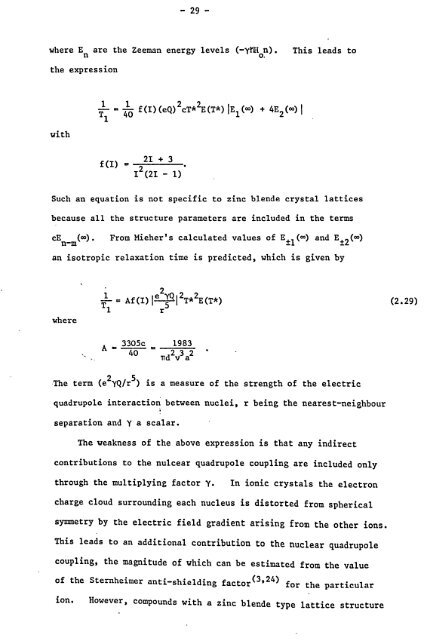NNR IN RAPIDLY ROTATED METALS By - Nottingham eTheses ...
NNR IN RAPIDLY ROTATED METALS By - Nottingham eTheses ...
NNR IN RAPIDLY ROTATED METALS By - Nottingham eTheses ...
You also want an ePaper? Increase the reach of your titles
YUMPU automatically turns print PDFs into web optimized ePapers that Google loves.
- 29 -<br />
where En are the Zeeman energy levels (-yM n). This leads to<br />
the expression<br />
with<br />
11a<br />
1<br />
f (I)<br />
40<br />
f (I) (eQ)2cT*2E(T*) JE1(co) + 4E2(o) I<br />
21 +3<br />
I2(2I - 1)<br />
Such an equation is not specific to zinc blende crystal lattices<br />
because all the structure parameters are included in the terms<br />
cEn_m(()0). From Mieher's calculated values of E+1(co) and E+2(oo)<br />
an isotropic relaxation time is predicted, which is given by<br />
where<br />
T=<br />
A<br />
1r<br />
Af (I)<br />
e2 YQ ZT*2E (T*)<br />
3305c 1983<br />
40<br />
71d2v 3 a2<br />
The term (e2yQ/r5) is a measure of the strength of the electric<br />
quadrupole interaction between nuclei, r being the nearest-neighbour<br />
separation and ya scalar.<br />
The weakness of the above expression is that any indirect<br />
contributions to the nulcear quadrupole coupling are included only<br />
through the multiplying factor y. In ionic crystals the electron<br />
charge cloud surrounding each nucleus is distorted from spherical<br />
symmetry by the electric field gradient arising from the other ions.<br />
This leads to an additional contribution to the nuclear quadrupole<br />
coupling, the magnitude of which can be estimated from the value<br />
of the Sternheimer anti-shielding factor<br />
(3,24)<br />
for the particular<br />
ion. However, compounds with a zinc blende type lattice structure<br />
(2.29)

















